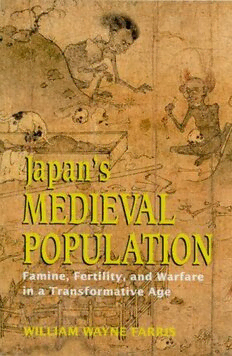
Japan's Medieval Population: Famine, Fertility, And Warfare in a Transformative Age PDF
386 Pages·2006·2.701 MB·English
Most books are stored in the elastic cloud where traffic is expensive. For this reason, we have a limit on daily download.
Preview Japan's Medieval Population: Famine, Fertility, And Warfare in a Transformative Age
Description:
This volume charts a course through never-before-surveyed historical territory: Japan’s medieval population, a topic so challenging that neither Japanese nor foreign scholars have investigated it in a comprehensive way. And yet, demography is an invaluable approach to the past because it provides a way—often the only way—to study the mass of people who did not belong to the political or religious elite. By synthesizing a vast cache of primary and secondary sources, William Wayne Farris constructs an important analysis of Japan’s population from 1150 to 1600 and considers social and economic developments that were life and death issues for ordinary Japanese. Impressive in his grasp of detail and the scope of his inquiry, Farris makes the argument that, although this age initially witnessed the continuation of a centuries-old demographic stasis, a far-reaching transformation began around 1280 and eventually gained momentum until it swept through the Japanese archipelago. Between 1280 and 1600, Japan’s population approximately trebled, growing from 6 million to 17 million. Crucial to the demographic breakthrough was the resolution of two central problems facing both the rulers and the ruled. The first was how to supply a burgeoning population with sufficient food; the second, how to keep the peace.Farris reveals that the solution to the first problem resulted from more productive agriculture taking place on more arable land, the rise of an expansive commercial network, new technologies in industry, and more cohesive social units such as the corporate village and stem family. Gradual improvements in housing, nutrition, clothing, sanitation, and other aspects of daily existence reduced infant mortality and boosted the standard of living for many commoners. The end to endemic warfare and removal of most warriors to the cities brought relief to a populace that had been constantly harassed by their military overlords, who stole their crops, kidnapped their wives and children, and exploited their labor. Farris makes the case that the benefits of peace were wrought by the peasantry through their hard work, ingenuity, and open resistance to a demanding and abusive warrior class. It was, moreover, peasant efforts that laid the groundwork for further gains made during Japan’s early modern period after 1600.Japan’s Medieval Population will be required reading for specialists in pre-modern Japanese history, who will appreciate it not only for its thought-provoking arguments, but also for its methodology and use of sources. It will be of interest as well to modern Japan historians and scholars and students of comparative social and economic development.
See more
The list of books you might like
Most books are stored in the elastic cloud where traffic is expensive. For this reason, we have a limit on daily download.
